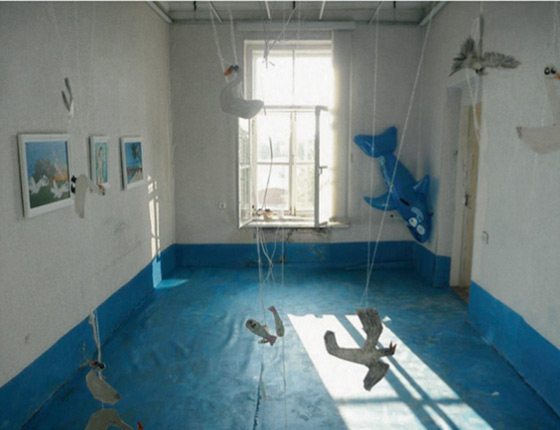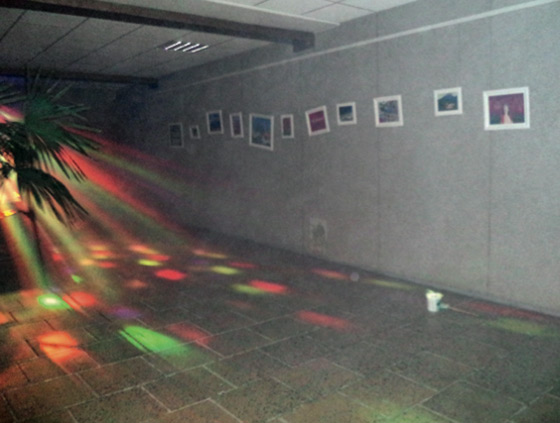|
|
| Margrieta Dreiblate. Art as a party Santa Mičule, Art critic | |
| On august 7th of 2014, Margrieta Dreiblate’s (b. 1991) exhibition Birds opened and closed for a few hours at the kaņepe culture centre. the exhibition served as a pretext to focus more detailed attention on dreiblate’s work, which flourishes and thrives mainly at marginal cultural spots or sometimes even at cultural non-spots, for example, the madona railway station or the Valka hospital. the consistent choice of unusual exhibition sites also corresponds with the artistic content of the exhibitions, which at their very source include opposition to the white cube aesthetic and institutionalism. but dreiblate has also taken part in art events of a larger scale, for example, group exhibitions organised by the kim? contemporary art centre, the Survival Kit art festival, the Vilnius art fair artVilnius and elsewhere, consequently gaining recognition outside of smaller towns as well. dreiblate is a student at the art academy of latvia’s department of Visual communication and, due to the fact that she works consciously with marginal forms of art, has already earned a sovereign place in latvian contemporary art. for reasons hard to explain, the impression arises that the loudest and boldest art concepts among dreiblate’s contemporaries – the generation born in the late 1980s and early 1990s – belong specifically to the fairer sex. the young female artists challenge, provoke and experiment in their works much more frequently than the representatives of the opposite sex, who play along with the usual rules of the artistic process without getting particularly carried away with breaching or extending any boundaries. at the moment it’s too early to formulate a specific term, exhibition or even a manifesto for this partly intuitive impression, but i hope that the feminist premonition will turn out to be genuine and we’ll experience some as yet unprecedented phase in latvian art. i consider dreiblate to currently be the most striking representative of this, my concocted “girl power” movement, but what she has created is also intriguing from completely different viewpoints for judging art. Art as “non-art” Dreiblate’s playing around with “anti-art”, “trash” and the kitsch aesthetic creates an interesting anarchistic art programme, the aesthetic non-conformism of which fills with content those gaps in the cultural space that elite (serious, commercial) art usually leaves unnoticed. it’s true that this division between high art and kitsch art (and i don’t mean this in the thoroughly obsolete clement greenberg understanding of theory) sometimes tends to become distorted; ivars grāvlejs comes to mind, this enfant terrible, who is exiled from posh exhibitions yet receives a nomination for the equally posh Purvītis Prize. the case of grāvlejs confirms that it is specifically so-called provocative art that is able to accurately diagnose disorders and deficiencies in the staid systems of art perception and evaluation, as outlined and argued by art historian inga šteimane in her justification of the nomination. | |
 View from Marine exhibiton at Customs House, Liepāja. 2013 Publicity photo Courtesy of the artist | |
| Dreiblate has chosen an unusual method of expression for a young artist (i apologise for the “label”). namely, in lieu of confirming her belonging to the art world and demonstrating a craftsman-like professionalism or maturity of thinking in the direction of a variety of pseudo-existential themes (which, at this age, often mask a lack of interest or the fact that “there’s really nothing to say”), she boldly uses brazen irony, stylised anti-professionalism and the tactic of infantilism, which are implemented with a faux naïf lightness. the young artist works mainly with images, documenting various scenes from everyday life and deriving a new world of images and motifs from them, in which, in line with kitsch culture’s theoretical principles, reality gets portrayed in a banalised, unrealistic form. Pronounced elements of marginality, burlesque and hyperbole bring dreiblate’s art close to the so-called “camp” phenomenon described by susan sontag – cultural phenomena, the content of which is formed from undisguised affectation, theatricality, irony, playfulness and overstatement. in camp, popular culture is shown by exaggerating its expression to the level of ridiculousness; at the same time, its camp nature also denies the serious, stiff and conventionally correct lifestyle. dreiblate, too, sometimes chooses to portray heroes who are better known by readers of Vakara Ziņas [a yellow press publication], not Studija, for example, the semi-nude inese kombule. as well as the pop-culture icons of the yellow press, “underground” electronic music has become a significant part of her creative work, and she has created various joint events as well as portrayed representatives from these circles. Portraits of musicians could be seen at the end of 2012 at an exhibition titled The newest Wave at kalnciema Quarter and, if one didn’t know about dreiblate’s passion for and belonging to this musical “wave”, they could also have been interpreted as witty irony, works about what it’s like to be a fan and about the personality cult. The discourse of marginality is one of the uppermost in both the visual execution (the previously described primitivism and anti-professionalism) of dreiblate’s work as well as the grounded choice of subject. their thematic scope can be compared with the merging of life and art in a peculiar “post-fluxus” manner, selecting the portrait as the territory and main media for this merging. even though mass culture often gets made fun of and mocked, in dreiblate’s works sympathy for the simple and democratic is expressed through mass culture, which is a phenomena that’s not really often encountered in exhibition halls. the “lovely”, poetic and smoothly groomed art representatives most often completely segregate themselves from the lowest expressions of pop culture or express bitterness and irony-filled contempt towards them. the artist’s protest is purely aesthetic and is not expressed as an active social position or as a defence of specific groups in society; instead, it grows from an attitude towards art as an extension of life and the distinguishing of artistic potential in completely non-artistic artefacts of daily life. in my opinion, that’s right where the power of “anti-art” works is hidden – they push the viewers out of their comfort zone and do not allow them to slip into a consumerist self-satisfaction, from which nobody is protected. Art as hooliganism Aesthetic hooliganism can be interpreted as a passive and perhaps even unconscious protest, but this rebelliousness is not angry; it can annoy a viewer’s narrow-minded feelings, not through knocking a hole in a wall, but by spraying a phallus or some obscene witticism on it. for example, ironic paraphrases about internet culture were exhibited at the one-night exhibition In Brief about What’s most Important in the waiting room at madona railway station. with a hacker-like scope, the characteristic language of image and communication codes of the internet subculture were “hacked”, transferring them to absurd miniature painting compositions in which simplified digital processing and montage techniques were copied. the result could be rhetorically compared to an internet carnival; one only has to imagine all of those symbols born from the binary code system as living creatures endowed with an awareness of their own identity. | |
 View from Margrieta Dreiblate’s In Brief about What’s most Important exhibiton at the Madona Railway Station. 2013 Publicity photo Courtesy of the artist | |
| Whereas, the Birds exhibition, in a sense, has been motivated by news services that spread information from dubious sources about the chinese moving to latvia, as a result of which all of latvia’s birds will get eaten, because they have already all been eaten in china. fantasising about these panicky scenarios, the exhibition offers “alternative solutions for those who want to eat birds” – photo reports with little characters that are “glued” together from food products, lying about on plates and neon tablecloths. what is visible at the exhibition is “digested”, like a conclusion regarding the fact that it’s possible to neutralise the absurd only with absurd methods, in a similar way as the hidden senselessness of some things is revealed much more visibly if it leads to even more open absurdity. In reviewing dreiblate’s participation in exhibitions, i do not wish to highlight just one, because they create a unified whole. however, her participation in the Unceasing group exhibition (kim? contemporary art centre 25.01–03.03.2013) created by iliana Veinberga has to be highlighted as her most significant, because the abnormality, rebelliousness and the arts relativism context realised in the exhibition very accurately respond to the uncomfortable aesthetic of dreiblate’s works. the Unceasing concept highlighted her ability to articulate the absurd and vulgar in a talented way, reducing it to a convincing consistency of style. in the exhibition, she exhibited comic strip compositions created by the Paint computer programme that were copied on paper with coloured pencils, gouache paints and similar student-like materials. the skewed clumsiness of the grotesque scenes was also strengthened by the back-to-front orthography and the nihilism included in the titles (i’d like to call it minor-nihilism). in the generally accepted interpretation, nothing really provides evidence of the presence of professional art in these works, unless it’s just the way that the drawings are laid out, wavy like tape-recorder tape and at times coming unstuck from the wall. in a less popular interpretation, the works are an outstanding example of subversive art, cunningly taking the searchers of simple art formulas and truth for a ride. By this, i don’t wish to say that dreiblate’s works are a bluff or an empty provocation; quite the opposite. Powerful literature, music, cinema or visual works of art encourage one to think about the human condition in this world, sometimes even helping one to understand it, even if just for a moment. most often art makes us (by “us” i mainly mean my own private experience) notice ourselves in a not very pleasing light, where the fatalism and absurdity of everything, one’s powerlessness and the awareness of one’s insignificance dominates. i don’t know whether it’s possible to change this sort of world order to something more positive in the long term, but dreiblate’s absurd, funny and shameless works offer an alternative to this condition – life and art as a party. Translator into English: Uldis Brūns | |
| go back | |







